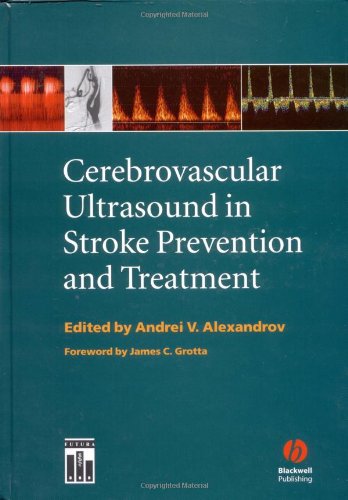

Most ebook files are in PDF format, so you can easily read them using various software such as Foxit Reader or directly on the Google Chrome browser.
Some ebook files are released by publishers in other formats such as .awz, .mobi, .epub, .fb2, etc. You may need to install specific software to read these formats on mobile/PC, such as Calibre.
Please read the tutorial at this link. https://ebooknice.com/page/post?id=faq
We offer FREE conversion to the popular formats you request; however, this may take some time. Therefore, right after payment, please email us, and we will try to provide the service as quickly as possible.
For some exceptional file formats or broken links (if any), please refrain from opening any disputes. Instead, email us first, and we will try to assist within a maximum of 6 hours.
EbookNice Team

Status:
Available4.4
23 reviews
ISBN 10: 1405128513
ISBN 13: 9781405103817
Author: Andrei V. Alexandrov, James C. Grotta
Ultrasound enables us to monitor the cardiovascular system and brain responses to treatment in real time; a genuine blessing on the route to more effective stroke therapies, and an invaluable tool with which to tailor treatment when available evidence is meagre. Ultrasound is a vital observational tool, yet a probe needs a scientist to point it in the right direction and a skilled physician to synthesise scientific data with practical management strategies.
This book, intended for clinicians who are eager to learn and prepared to observe, focusses on the examination of stroke patients, the interpretation of ultrasound studies, and the application of cerebrovascular ultrasound to management and treatment strategies. Produced by an international team of contributors and edited at the University of Texas, one of the major world centres in stroke research, it is a practical volume that can be used by beginners to learn the principles of ultrasound testing, by advanced users to learn differential diagnosis, and by clinicians (non-sonographers) who treat stroke patients. The latter will gain knowledge on how to apply ultrasound, and what to expect from it in terms of clinical decision making and treatment selection.
Part I: How to Perform Ultrasound Tests
Principles of Extracranial Ultrasound Examination
Intracranial Cerebrovascular Ultrasound Examination Techniques
Anatomy of the Brain’s Arterial Supply
Part II: Hemodynamic Principles
Integrated Assessment of Systemic and Intracranial Hemodynamics
Practical Models of Cerebral Hemodynamics and Waveform Recognition
Part III: Criteria for Interpretation
Diagnostic Criteria for Cerebrovascular Ultrasound
Part IV: Ultrasound in Stroke Prevention and Treatment
Ultrasound in Stroke Prevention: TCD and Sickle Cell Disease
Cardiovascular Risk Factors and Carotid Ultrasound
Applications of Functional Transcranial Doppler (fTCD)
Transcranial Doppler in the Detection and Quantitation of Patent Foramen Ovale and Other Right-to-Left Circulatory Shunts
Ultrasound in Neurocritical Care
Cerebral Vasospasm after Subarachnoid Hemorrhage
Intra-Operative TCD Monitoring
Intracranial Stenosis
Ultrasound in Acute Stroke: Diagnosis, Reversed Robin Hood Syndrome and Sonothrombolysis
Ultrasound and Gaseous Microspheres
Neurosonology Pearls
cerebrovascular scan
stroke ultrasound
most common artery for stroke
what scans are done for stroke
cerebrovascular ultrasound in stroke prevention and treatment
Tags: Andrei Alexandrov, James Grotta, Cerebrovascular Ultrasound, Stroke Prevention